

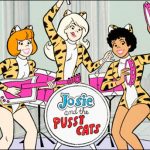
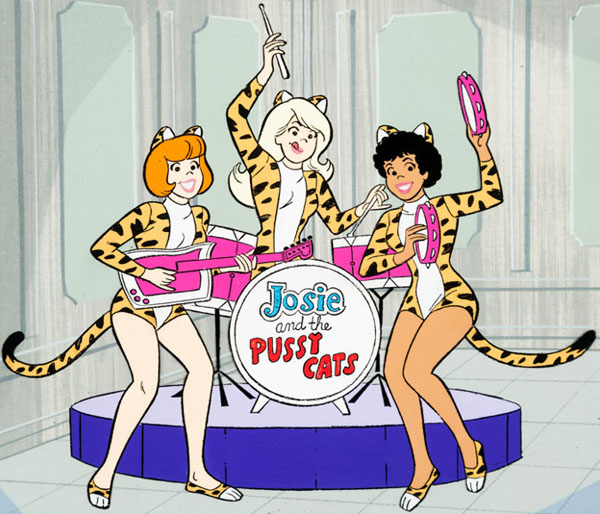
In an ongoing landscape of superhero and pop music franchises, only a handful have set as many precedents, saved the world from destruction, conquered evil throughout the galaxy, and continued to rock the world quite like Josie and the Pussycats.
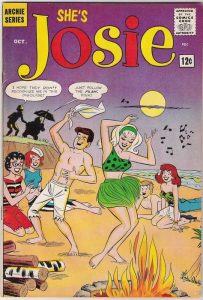 Archie Comics still publishes new stories and reprints classics featuring the characters. Reruns of the two original Hanna-Barbera animated series endlessly entertain longtime and new fans, most recently on MeTV Toons. It inspired a 2001 feature film. The characters popped up in the Riverdale teen soap.
Archie Comics still publishes new stories and reprints classics featuring the characters. Reruns of the two original Hanna-Barbera animated series endlessly entertain longtime and new fans, most recently on MeTV Toons. It inspired a 2001 feature film. The characters popped up in the Riverdale teen soap.
The character of Josie was based on a real person, Josie DeCarlo, the wife of legendary comic book artist Dan DeCarlo, best known for establishing the classic Archie “house style.” The Josie idea began as a comic strip that he sold to Archie Comics in 1963 for a companion series of teen comedy stories. Like Ginger and That Wilkin Boy, the Josie comics took place in high school and suburban settings similar to those of Archie Andrews, whose character would occasionally crossover with the Josie gang.
The first six years of Josie and She’s Josie consisted of hometown situation comedies, with a short venture into “Sabrina” territory when Alexandra was able to cast hapless magic spells with her cat, Sebastian, as a magical familiar.
The mammoth ratings of Filmation’s Archie Show on CBS – and the number one status of the show’s bubblegum single “Sugar, Sugar” – inspired several Saturday morning pop groups. CBS daytime chief Fred Silverman chose Hanna-Barbera’s concept for Josie and company in international misadventures, which distinguished it from the various TV incarnations of Archie. They would become television’s first fictional female pop band (unless you count The Bradley Sisters of Petticoat Junction, or Samantha and Serena rockin’ on Bewitched).
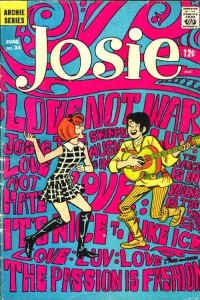 Hanna-Barbera’s “Jonny Quest meets The Monkees” format never appeared in any Josie comic books or subsequent films or cartoons, though H-B itself reconfigured the premise for such series as Butch Cassidy and Jabberjaw. The comic book versions remain limited to domestic and show business stories, with some ventures into the supernatural, depending on the Archie “universe.”
Hanna-Barbera’s “Jonny Quest meets The Monkees” format never appeared in any Josie comic books or subsequent films or cartoons, though H-B itself reconfigured the premise for such series as Butch Cassidy and Jabberjaw. The comic book versions remain limited to domestic and show business stories, with some ventures into the supernatural, depending on the Archie “universe.”
The TV series began development in 1969. Because Archie could produce and publish new issues faster than an animated series, the “Josie and the Pussycats” band was introduced in comic books that December, while the TV show would not premiere until the following September.
Hanna-Barbera cast separate singing voices and speaking voices for each of the three band members. The wondrous Janet Waldo voiced Josie, though she explained to TV historian Stu Shostak that she was not the first Josie. Judy Waite, whose name appears in some early end credits, was cast as Josie. She had difficulty recording the intricate dialogue—not for the cartoon series, but for the interstitial “In the Know” mini-documentaries produced by CBS News. The precursor to “In the News” narrated by newscaster Christopher Glenn, “In the Know” consisted of filmed segments focusing on issues, travel, and various other subjects, narrated by Josie, Valerie, Melody, Alan, Alex, and Alexandra.
Casey Kasem, who had just entered the voice acting profession as Shaggy on Scooby-Doo, Where Are You! played Alexander Cabot III. Like so many fine voice actors, Kasem’s Alex is similar to his Shaggy voice, a chicken-hearted fellow, but sporting a slightly more assertive attitude (however flawed his skills might have proved to be) as the Pussycats’ manager. Announcer and radio personality Jerry Dexter, who had already entered Saturday morning on such series as Shazzan and The Adventures of Gulliver, was cast as Alan. Hanna-Barbera superstar Don Messick, king of the giggling dog and cat voices, played Sebastian.
Sherry Alberoni of The Mickey Mouse Club, The Three Worlds of Gulliver, and a variety TV series, helped give Alexandra an edge that was unprecedented in TV animation, much less animation in general. The writers had a field day as Alexandra schemed to take over the band, steal Josie’s boyfriend, and snarl right back at the villains, often calling them “creeps.” The beloved character actor Jackie Joseph, who deftly stole scenes on The Dick Van Dyke Show, The Doris Day Show, and Roger Corman’s original Little Shop of Horrors, brought her tinkling, giggling persona to Melody, whose comic book dialogue balloons were festooned with musical notes.
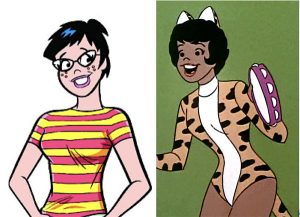 The character originally chosen from the Josie comic books as the third Pussycat was a bespectacled brunette named Pepper. Her eventual replacement resulted in a precedent in Saturday morning television animation.
The character originally chosen from the Josie comic books as the third Pussycat was a bespectacled brunette named Pepper. Her eventual replacement resulted in a precedent in Saturday morning television animation.
Music producer Danny Janssen, who was enjoying success at the time with the records of Bobby Sherman, was hired to provide the songs. Janssen had co-written Sherman’s hits, “Little Woman” and “La La La,” (the latter also performed by the Pussycats for their LP) for his “La La Productions.” From the dozens of auditions, he selected the three best singers for the roles. The trio needed to have strong, charismatic stage presences as well as great voices. Unlike The Archies, whom the comic book publisher wished to be entirely behind the scenes, Josie and the Pussycats were intended to sing in concerts as well as for the cartoon.
Cathy Dougher’s stage background, versatile range, and girl-next-door look made her the perfect singing Josie. The young hopeful who sang for Melody, known at the time as Cherie Moor (born Cheryl Jean Stoppelmoor), later became a household name as Cheryl Ladd.
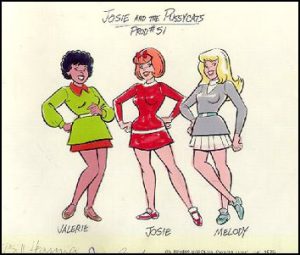 The circumstances surrounding the inclusion of an African American voice in the Pussycats have been seriously misreported in several accounts, either because of insufficient data, or to sensationalize the story at the expense of others. What follows reflects the most accurate and up-to-date research (in addition to the text in my Hanna-Barbera book). According to Danny Janssen’s liner notes for the 2001 Rhino Handmade compilation CD, he submitted his demos and photos to the studio unaware that all three characters in the Archie comic book were Caucasian. Hanna-Barbera’s art and animation elements were already approved by Silverman and Broadcast Standards at CBS, sponsors Kellogg’s and Mattel, and TV parent groups. Patrice Holloway, a highly respected studio vocalist and songwriter (“God Bless the Child”) would certainly bring an genuine female R&B sound to the group, but a new character would have to be created to replace Pepper. This presented a perplexing challenge. To go back to square one and change the character to a brand new one, as there had never before been regular Black characters in the Josie comic books.
The circumstances surrounding the inclusion of an African American voice in the Pussycats have been seriously misreported in several accounts, either because of insufficient data, or to sensationalize the story at the expense of others. What follows reflects the most accurate and up-to-date research (in addition to the text in my Hanna-Barbera book). According to Danny Janssen’s liner notes for the 2001 Rhino Handmade compilation CD, he submitted his demos and photos to the studio unaware that all three characters in the Archie comic book were Caucasian. Hanna-Barbera’s art and animation elements were already approved by Silverman and Broadcast Standards at CBS, sponsors Kellogg’s and Mattel, and TV parent groups. Patrice Holloway, a highly respected studio vocalist and songwriter (“God Bless the Child”) would certainly bring an genuine female R&B sound to the group, but a new character would have to be created to replace Pepper. This presented a perplexing challenge. To go back to square one and change the character to a brand new one, as there had never before been regular Black characters in the Josie comic books.
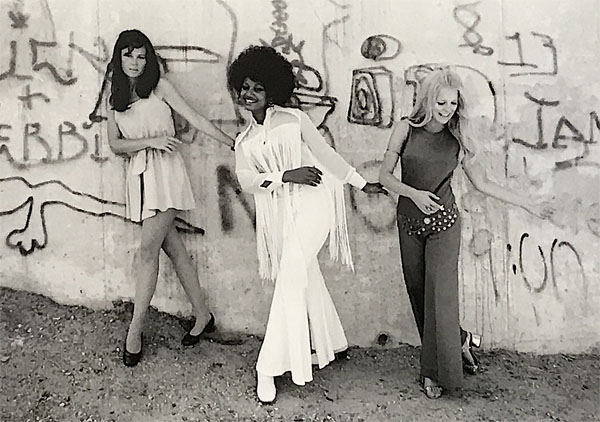
Cathy Dougher, Patrice Holloway and the future Cheryl-Ladd in a publicity photo for Josie and the Pussycats.
Before 1969, there were no African American cartoon characters on Saturday morning cartoons. Filmation was first, with Pete Jones on The Hardy Boys. Jazz and blues singer/drummer Rob Crowder performed Pete’s singing and is pictured on the two album covers, but Pete’s speaking voice was the same as Chuck Clayton in Filmation’s Archie shows. Veteran voice actor Dal McKennon provided both, though he was not Black. This was common practice, even in 21st-century cartoons, and has only recently been remedied.
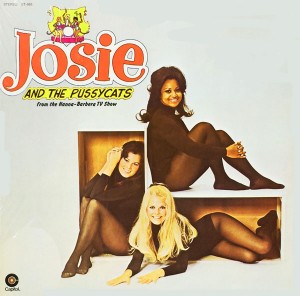 Back in 1969, Hanna-Barbera did not have the last word on altering the approved artwork and supporting materials, as well as possible production schedule and budget changes. Bill and Joe ran the studio, but they had to answer to their parent company, Taft Broadcasting, as well as all the entities mentioned above, plus work with Archie Comics to replace Pepper. Janssen said that he could not bring himself to remove Patrice Holloway from the trio. His only alternative was to ask to leave the project.
Back in 1969, Hanna-Barbera did not have the last word on altering the approved artwork and supporting materials, as well as possible production schedule and budget changes. Bill and Joe ran the studio, but they had to answer to their parent company, Taft Broadcasting, as well as all the entities mentioned above, plus work with Archie Comics to replace Pepper. Janssen said that he could not bring himself to remove Patrice Holloway from the trio. His only alternative was to ask to leave the project.
“They were very nice about it,” Janssen said, and they all agreed that he could return for future music projects. In a short time, however, Hanna-Barbera did indeed obtain all the necessary approvals and the character of Valerie was created. Pepper disappeared from the comic book (along with supporting characters Albert and Sock (a nickname for “Socrates”). December 1969 saw the first appearances of Valerie, the Pussycats band, and hunky Alan Mayberry (“Alan M” in comics, “Alan” in the cartoon). The timeline of Valerie’s debut in the comic book bears out the production timeline of the series and the development of the merchandise design guides, which also include Valerie. They all tied together.
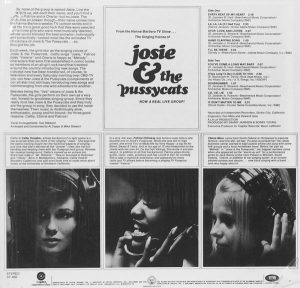
Back of the album – Click to enlarge.
Josie and the Pussycats premiered on September 12, 1970. Capitol Records released one soundtrack LP, two singles for radio play, and four Kellogg’s singles available by mail. Alas, there was no live tour; Janssen believes that Capitol dropped the ball and failed to make it happen.
The theme song was written by Hoyt Curtin, with Bill Hanna and Joe Barbera under the pseudonyms of Denby Williams and Joseph Roland. Denby was Bill’s middle name from birth, and Roland was a middle name Joe created for himself. Most of the background cues were written by Ted Nichols, including some from previous series, particularly 1968’s The New Adventures of Huckleberry Finn.
CBS ran its order of 16 episodes six times for two years, which was the general way shows were broadcast during this Saturday morning era. CBS had the option of asking Hanna-Barbera to produce eight more episodes of the same series. Instead, CBS and H-B developed a spinoff of sorts, Josie and the Pussycats in Outer Space. This allowed the network to promote a “new” 16-episode series rather than simply add eight episodes to the earlier one.
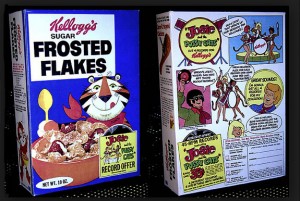 By 1972, the prospect of launching another Archie-like music phenomenon had proved unfruitful. Even The Archies themselves had scaled the songs down. For Archie’s Funhouse, in addition to songs from the group’s four albums, a handful of shorter, less elaborate tunes were recorded by Ron Dante and never officially released on records. The same was true when the Pussycats became lost in space. Ten new songs were played in the series, but they were much shorter, did not involve Danny Janssen, and are also unreleased on disc.
By 1972, the prospect of launching another Archie-like music phenomenon had proved unfruitful. Even The Archies themselves had scaled the songs down. For Archie’s Funhouse, in addition to songs from the group’s four albums, a handful of shorter, less elaborate tunes were recorded by Ron Dante and never officially released on records. The same was true when the Pussycats became lost in space. Ten new songs were played in the series, but they were much shorter, did not involve Danny Janssen, and are also unreleased on disc.
Writer/directors Harry Elfont and Deborah Kaplan brought a live-action Josie and the Pussycats to the big screen amid much fanfare and heavy promotion. The clever premise of consumer manipulation was lost on audiences, however, and critics were miffed that such a highly commercial production was preaching the evils of mass media seduction while spending millions doing what they saw as a similar thing for the film. An unfortunate side effect of the movie was a ”divorce” between Dan DeCarlo and Archie Comics due to litigation for compensation.
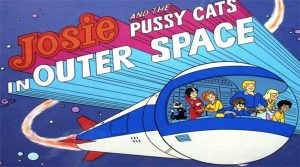 Time has faded that objection since, and the feature film, as well as its quality pop songs, has gained a loyal audience. The film’s stars, Rachel-Leigh Cook, Tara Reid, and Rosario Dawson turned up to sign copies of the soundtrack album when it was reissued on vinyl.
Time has faded that objection since, and the feature film, as well as its quality pop songs, has gained a loyal audience. The film’s stars, Rachel-Leigh Cook, Tara Reid, and Rosario Dawson turned up to sign copies of the soundtrack album when it was reissued on vinyl.
The original cartoon cast reunited in an episode of Stu’s Show, in which Stu Shostak interviewed Janet Waldo, Jackie Joseph, Barbara Pariot, Sherry Alberoni, and Jerry Dexter. This would be the last time they would all be gathered. They were very proud of their association with the two series. Barbara Pariot had no idea she was making history at the time but was delighted to discover how the series continues to entertain and gain new fans.
Archie Comics still prints new Josie and the Pussycats stories in various comic digests and special issues. The digests are a treasure trove of classic stories that not only feature Archie and the gang, but occasionally other characters like Li’l Jinx, Wilbur, and Ginger. Both the pre- and post-band Josie comics turn up regularly. Guitars and sharps and flats galore.
“It Don’t Matter to Me” – Josie and the Pussycats
Some songs on the Capitol LP were late sixties/early seventies hits that were not heard on the TV cartoon series, like “Close to You” and “I’ll Be There.” One hit song had an unintended Hanna-Barbera connection: 1969’s “It Don’t Matter to Me,” written by David Gates for his band, Bread. Five years earlier, Gates contributed the title song to H-B’s first feature, Hey There, It’s Yogi Bear.